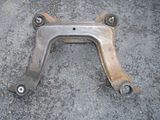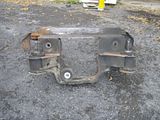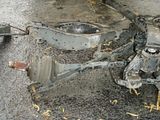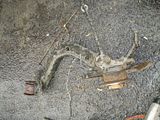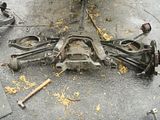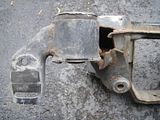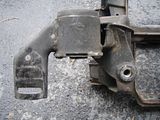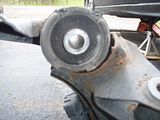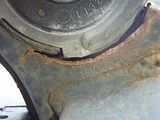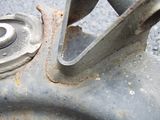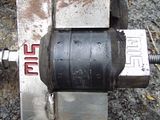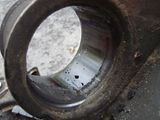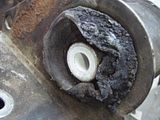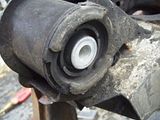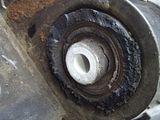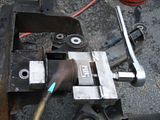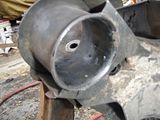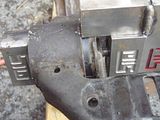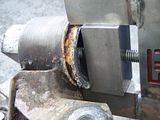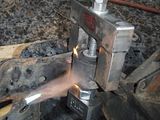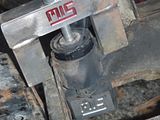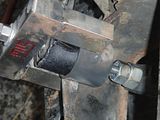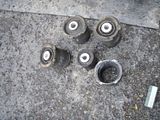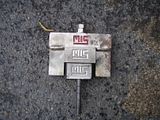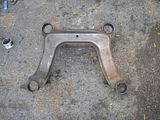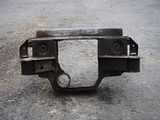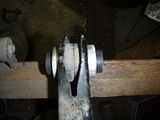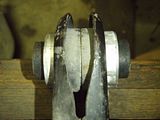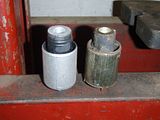So, like many '95 M3 owners, I was plagued by an intermittent CEL, generally between shifts 1-2 where the CEL would illuminate briefly, then go out. I could always feel a flat spot in the lower RPM range, and the car didn't feel like it had the amount of torque at the initial stab of the throttle like I assumed it should have. I would get code 1226 frequently, and frankly, it annoyed the piss out of me. Then, recently, I started getting code 1225 (knock sensor #1) every time it rained. At this point, the CEL would come on and stay on. I can't stand any orange warning lights shining in my face at night- time to fix the problem!
I ordered two new OEM Bosch knock sensors from RMEuropean a few weeks back, and decided I'd take a stab at it last night. My car is a 10/94 build, and I'd read that you must remove the intake manifold to get to KS #2. I wasn't about to do that, as I had the manifold off earlier this year and totally forgot to deal with the KS issues. (ugh )
So I grabbed a 3/8" drive ratchet, a universal joint, a plethora of extensions, a florescent drop light, and a flat head screwdriver. I disconnected the TPS/removed the the throttlebody, unbolted the charcoal canister, unclipped the intake air temp sensor under the back side of the manifold near the brake booster/firewall, removed the alternator air duct, the hose off the lower part of the ICV, and the rest of the intake pipe (filter/silicone boot/MAF).
Note: click any of the pics to enlarge them.
Immediately upon looking in, I located knock sensor #1. I removed and inspected it. Here's what I found. Note there are three visible cracks on the plastic housing, and the chafed wire.
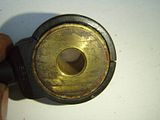
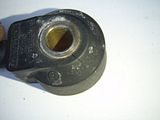
Chafed wire. On the new knock sensors, I put a piece of split loom wire covering on them. It fit perfectly (it's 3/8" for those of you wondering what size), and should help protect from this happening again. I also made sure when I torqued down the KS's that the wires weren't touching anything solid:
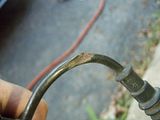
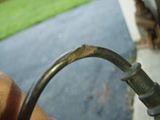
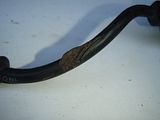
And here you can see the boss on the block where #1 goes:
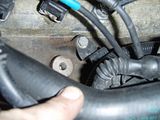
Here are pics of one of the two brand new OEM Bosch Knock sensors:
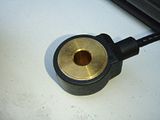
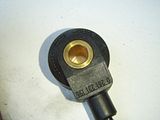
And the last pic- the only stuff I removed to replace both knock sensors. It took a total of 2.5hrs from start to finish to do this. Not bad at all.
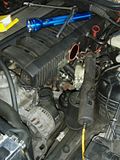
I have no pics of doing KS #2- but rest assured, it's a bit more difficult than #1 (and I couldn't fit the camera in there either, too much crap in the way and I was in a hurry), but it's definitely doable from up top with basic hand tools!
No pics of it installed, but you get the point. Now moving on to the rear sensor. Unfortunately, I was in a hurry (didn't want to take my pickup to work today, so I went quickly, didn't take many pics )
As I previously stated, pulling the intake manifold was not an option. I just didn't feel like doing it again, even though it wouldn't have taken that much time. (keep in mind I started this around 7pm, finished by 9:30pm when it was fully dark out)
Above KS #2, there is a metal bracket. I'm guessing that someone prior to me had the manifold off before, as even when I pulled the manifold a few months ago, nothing was connected to it. Grabbed my trusty ratchet, slapped on a 1' extension with the universal joint and a 13mm socket. I reached in from the brake booster area past the starter. (YES, I had already unplugged the battery!) Got that bracket out no problem. It's two 13mm bolts. It's a bit tricky, but easy once you figure out that you need to move the main engine harness, and push that spider-looking coolant pipe out of the way. I wrapped a piece of speaker wire around them and tied them up to the manifold through those little holes.
Once that was removed, I tied a small piece of rope to the other bracket that's down there, and pulled out a few of the bolts for that as well. I tied it up to the oil fill cap, and it revealed the rear knock sensor! (#2- you know, the one that it seems is impossible to get from the top?)
Less than ten minutes later, I had the knock sensor removed, the boss on the block cleaned up, and the new sensor torqued back down (15ft lbs). Connect the wire, back in business! I then re-connected the intake air temp sensor, looked for any leaks (there were none, of course!), and started plugging things back in. Once I got everything under the manifold situated as far as the electronics go, I clamped on the lower ICV pipe, double-checked everything again, and re-installed everything else.
I wish I'd taken pics of this, but I hate driving my pickup in good weather. This is driving weather, and the pickup is NOT a "driver's" vehicle!
Every time I used to get in the car, I'd get that CEL flash between shifts 1-2, and the 1226 code would register. The car would have a flat spot in the lower RPM, felt like I was missing torque. (I WAS!) Now the car accelerates MUCH smoother than before, and has a noticeable amount more torque lower in the RPM band. It's not PUSH YOU IN THE SEAT better, but it's... much more "around town" friendly. When I roll into the skinny pedal, it does it's gentle "brace your neck" a bit better feeling. I adore it.











